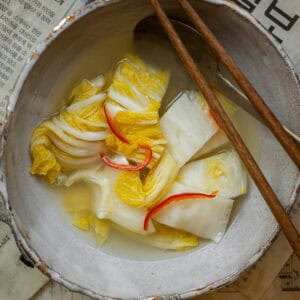
Vegan White Kimchi (Baek Kimchi).
A delicious and easy to follow vegan white kimchi recipe.
Ingredients
For Salting Cabbage Heads
- 1 cup coarse sea salt
- 1 head Napa cabbage (~3 pounds)
For White Kimchi Broth
- 1 cup peeled, rough chopped apple
- 1/2 cup peeled, rough chopped onion
- 10 green onions (untrimmed but thoroughly washed)
- 7 to 8 peeled garlic cloves
- 1 thumb peeled ginger
- 1 cup rough chopped Korean radish
- 1 cup peeled rough chopped Korean pear
- 3 red chile peppers, seeded and thinly sliced
- 4 to 6 tbsp sea salt
Instructions
Salting the Cabbage.
- Begin by creating the brine for your white kimchi--in a large bowl, mix 3/4 cups of salt with 1 quart of very cold water, until the salt dissolves. Set aside.
- Remove any extra "stub" at the butt or root end of your cabbage head (mine usually come quite neatly trimmed). Cut a 2-inch slit down the root end of your cabbage end. Then, using your hands, split the cabbage head in two. Repeat with the two halves of cabbage--cut a slit at the root end and use your bare hands to split them in half. You should have four cabbage quarters.
- Use the remaining 1/4 cup of salt to sprinkle over each individual cabbage leaf by pulling the inner leaves of each quarter towards you and sprinkling a little salt on the bottom leaf. You want to pay particular attention to the white part of the cabbage, which is the thickest. This part will require more salt to wilt and pickle than the leafier, green parts. Repeat with each leaf of the cabbage quarter.
- Then, place each quarter face down in the bowl of the salt brine you created in Step 1. For the next 2 to 6 hours, flip the cabbage quarters every 30 to 45 minutes so that they are equally exposed to the salt water. You will know that your cabbage is ready when the thickest parts of the cabbage head are quite pliable. Depending on how large and thick your cabbage head is, this can take anywhere from 2 to 6 hours.
Make the White Kimchi Broth.
- While your cabbage is pickling, make the kimchi broth by blending together your onion, Korean pear, Korean radish, apple, garlic, and ginger, with 1 cup of water. Then, strain the blended ingredients through a mesh strainer into a large container that's large enough to house your cabbage heads (remember, they will shrink considerably in the next several hours). Add 1 quart of cold water to the strained ingredients (you can strain the water together with the blended ingredients, a little bit at a time, as it helps with straining). Mix in 4 to 6 tablespoons of salt to the liquid--it should taste "too salty," but that saltiness will dissipate over time and optimize the fermentation process.
- Once you've determined that your cabbage leaves are ready, drain all the salt water and make sure you rinse the cabbage leaves thoroughly in cold water. The general rule is to rinse them each twice. Squeeze out excess liquid and pat them dry as best you can with a kitchen towel. Then, place them, face down, in the large container containing your white kimchi broth. Press down on them to remove any air bubbles.
- Add your green onion, whole, directly to your cabbage heads. Ideally, your cabbage heads should be in a container where they are completely submerged or pressed down. If you don't have a container that fits the cabbage heads, add a layer of plastic wrap to the top of the kimchi before closing the lid.
- Leave your white kimchi out at room temperature for 3 days. Give your kimchi a taste. If it hasn't fermented as much as you'd like (i.e., because your cabbage leaves are very thick), let it sit at room temperature another day. Afterwards, store in the refrigerator.
Nutrition
Serving: 2ouncesCalories: 15kcalCarbohydrates: 3gProtein: 1gFat: 0.1gSaturated Fat: 0.02gPolyunsaturated Fat: 0.04gMonounsaturated Fat: 0.01gSodium: 2100mgPotassium: 116mgFiber: 1gSugar: 2gVitamin A: 170IUVitamin C: 16mgCalcium: 31mgIron: 0.3mg
Tried this recipe?Let us know how it was!